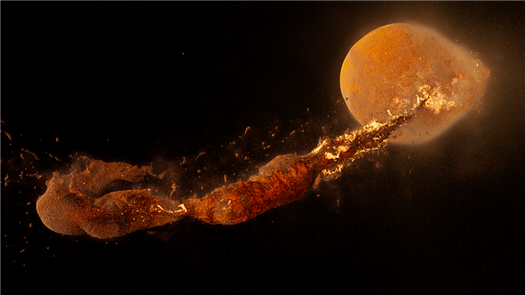The final Apollo Moon mission was in 1972. Scientists have had decades to investigate lunar samples and data from the Apollo missions, combine it with information returned by subsequent lunar missions, come to conclusions, and form new questions. They know what to target during the upcoming Artemis missions to help solve some of the outstanding mysteries.
Inside & Out
Several theories about our Moon’s formation vie for dominance, but almost all share that point in common: near the time of the solar system’s formation, about 4.5 billion years ago, something ― perhaps a single object the size of Mars, perhaps a series of objects ― crashed into the young Earth and flung enough molten and vaporized debris into space to create the Moon.

The early solar system would have been a chaotic, terrifying place. Debris left over from the formation of the Sun coalesced into a disk around the star, creating clumps that ranged in size from dust flecks to minor planets. Gravity drew these objects together, causing them to crash into each other ― violent smashups that could end in obliteration or new, larger objects. Those mashed-together objects make up the planets, moons, asteroids and other solar system objects we know today.
Written in Stone
Written in Stone
- The chemical composition of Moon and Earth rocks are very similar.
- The Moon was once covered in an ocean of magma.
- Meteorites have shattered and melted rocks on the Moon’s surface through impacts.
- Lava flowed up through cracks in the Moon’s crust and filled its impact basins.
- Lunar “soil” is made of pulverized rock created by meteorite impacts.
Visiting the Moon with the Apollo missions in the late 1960s and early 1970s revolutionized our understanding of the Moon’s origins. Previous concepts ― that the Moon was an object captured by Earth’s gravity as it sailed by, or that the Moon formed alongside Earth from the same debris ― fell out of favor after the Apollo missions brought back data and 842 pounds (382 kilograms) of lunar samples to Earth in the late 1960s and early 1970s. The Apollo evidence all pointed to the Moon forming from a large impact. The age of the rock samples indicated that the Moon formed around 60 million years after the solar system began to form. The type and composition of the samples showed that the Moon had been molten during its formation and was covered with a deep ocean of magma for tens of millions to hundreds of millions of years ― an environment that would occur in the aftermath of an intensely energetic impact. Lunar rocks were found to contain only small amounts of elements that vaporize when heated, further indicating the Moon could have formed in a high-energy impact that let those elements escape.

Perhaps most importantly, the rock samples indicated that the Moon was once a part of Earth. Basaltic rocks from the Moon’s mantle have striking similarities to basaltic rocks from Earth’s mantle. The oxygen isotopes and other elements sealed into the specimens matched those of Earth rocks too precisely for the similarities to be a coincidence.

Meteorites make up another body of evidence. Samples collected by Apollo astronauts come from just a few sites on the Moon, but lunar meteorites ― rocks sent into space by impacts on the Moon that eventually find their way to Earth ― provide samples from all over the Moon that tell a similar tale of the Moon’s history. Meteorites originating from asteroids have also been used to help confirm the timeline of the Moon’s formation. Some show signs of having been bombarded by debris from the giant, Moon-forming impact.
Finally, more recent studies add the evidence for a high-energy impact that resulted in the creation of a molten Moon. Analysis of light reflecting off the Moon gives details of the mineral makeup of the Moon’s surface, and it shows the widespread presence of anorthosite, an igneous rock that crystallizes out of and floats to the top of magma. The presence of anorthosite across the Moon’s surface reinforces that the Moon must once have been covered by a widespread magma ocean that was quite deep, from hundreds to thousands of kilometers.
Lunar “Archaeology”
Though Earth and Moon both came from that ancient collision ― and Earth is certainly within easier reach ― studying the Moon gives us our best chance of understanding what happened all those billions of years ago. Earth’s active geological processes, from plate tectonics to erosion, erase the evidence of formation. Aside from events like impacts, much of the Moon’s surface changes on a vastly slower timescale. Like detectives at a crime scene, scientists use clues preserved on the lunar surface to piece together the Moon’s history. Any improvements to the giant impact theory or a new theory would need to explain what we observe of the Moon today.

One of the oddities is the Moon’s low iron content as compared with Earth’s. Earth’s iron-rich core accounts for around 30 percent of its mass, but the core of the Moon is only about 1.6-1.8 percent of its total mass. One possible explanation is that the energy of the impact with Earth that formed the Moon vaporized lighter materials, casting them into space, and left behind heavier elements ― such as iron, which vaporizes only at extremely high temperatures ― to sink into Earth’s core.
Any viable theory of lunar formation also has to explain where the Moon is now in relation to Earth and the speed and inclination of its orbit. Surface reflectors placed on the Moon during Apollo show that the Moon moves away from Earth at the rate of about an inch and a half per year. This indicates that the Moon initially formed much closer to our planet, and, therefore, that the early Earth’s spin rate was much higher than it is today. Computer models created by scientists to test and analyze Moon formation theories must show how a massive collision can produce the existing orbits and rotation of Moon and Earth over billions of years when paired with the typical gravitational interactions between the two bodies. (Even today, the distance between the Earth and Moon, and the length of a day on Earth, continues to grow due to the effects of Earth’s tides.)
Finally, strange discrepancies exist between the Moon’s near and far sides. Differences include: the thickness of the crust ― 43 miles (70 kilometers) on the Moon’s near-side versus 93 miles (150 kilometers) on the far side; the contrasting geological makeup, including a concentration of radioactive elements on the near side; and the rich history of volcanism on the near side compared with a relative lack of volcanic activity on the far side. How closely these differences are related to the Moon’s formation ― how it cooled, how its volcanic activity took place, and the manner in which it has been bombarded by objects from space ― is a question scientists continue to wrestle with today.

Model Behavior
Collision May Have Formed the Moon in Mere Hours, Simulations Reveal

Billions of years ago, a version of our Earth that looks very different than the one we live on today was hit by an object about the size of Mars, called Theia – and out of that collision the Moon was formed. How exactly that formation occurred is a scientific puzzle researchers have studied for decades, without a conclusive answer.
Most theories claim the Moon formed out of the debris of this collision, coalescing in orbit over months or years. A new simulation puts forth a different theory – the Moon may have formed immediately, in a matter of hours, when material from the Earth and Theia was launched directly into orbit after the impact.
“This opens up a whole new range of possible starting places for the Moon’s evolution,” said Jacob Kegerreis, a postdoctoral researcher at NASA’s Ames Research Center in California’s Silicon Valley, and lead author of the paper on these results published in The Astrophysical Journal Letters. “We went into this project not knowing exactly what the outcomes of these high-resolution simulations would be. So, on top of the big eye-opener that standard resolutions can give you misleading answers, it was extra exciting that the new results could include a tantalisingly Moon-like satellite in orbit.”
The simulations used in this research are some of the most detailed of their kind, operating at the highest resolution of any simulation run to study the Moon’s origins or other giant impacts. This extra computational power showed that lower-resolution simulations can miss out on important aspects of these kinds of collisions, allowing researchers to see new behaviors emerge in a way previous studies just couldn’t see.
A Puzzle of Planetary History
Understanding the Moon’s origins requires using what we know about the Moon – our knowledge of its mass, orbit, and the precise analysis of lunar rock samples – and coming up with scenarios that could lead to what we see today.
Previously prevailing theories could explain some aspects of the Moon’s properties quite well, such as its mass and orbit, but with some major caveats. One outstanding mystery has been why the composition of the Moon is so similar to Earth’s. Scientists can study the composition of a material based on its isotopic signature, a chemical clue to how and where an object was created. The lunar samples scientists have been able to study in labs show very similar isotopic signatures to rocks from Earth, unlike rocks from Mars or elsewhere in the solar system. This makes it likely that much of the material that makes up the Moon originally came from Earth.
In previous scenarios where Theia sprayed out into orbit and mixed with only a little material from Earth, it’s less likely we’d see such strong similarities – unless Theia was also isotopically similar to Earth, an unlikely coincidence. In this theory, more Earth material is used to create the Moon, particularly its outer layers, which could help to explain this similarity in composition.
There have been other theories proposed to explain these similarities in composition, such as the synestia model – where the Moon is formed inside a swirl of vaporized rock from the collision – but these arguably struggle to explain the Moon’s current orbit.
This faster, single-stage formation theory offers a cleaner and more elegant explanation for both these outstanding issues. It could also give new ways to find answers for other unsolved mysteries. This scenario can put the Moon into a wide orbit with an interior that isn’t fully molten, potentially explaining properties like the Moon’s tilted orbit and thin crust – making it one of the most enticing explanations for the Moon’s origins yet.
Getting closer to confirming which of these theories is correct will require analysis of future lunar samples brought back to Earth for study from NASA’s future Artemis missions. As scientists gain access to samples from other parts of the Moon and from deeper beneath the Moon’s surface, they will be able to compare how real-world data matches up to these simulated scenarios, and what they indicate about how the Moon has evolved over its billions of years of history.
A Shared Origin
Beyond simply learning more about the Moon, these studies can bring us closer to understanding how our own Earth became the life-harboring world it is today.
“The more we learn about how the Moon came to be, the more we discover about the evolution of our own Earth,” said Vincent Eke, a researcher at Durham University and a co-author on the paper. “Their histories are intertwined – and could be echoed in the stories of other planets changed by similar or very different collisions.”
The cosmos is filled with collisions – impacts are an essential part of how planetary bodies form and evolve. On Earth, we know that the impact with Theia and other changes throughout its history are part of how it was able to gather the materials necessary for life. The better scientists can simulate and analyze what’s at play in these collisions, the more prepared we are to understand how a planet could evolve to be habitable like our own Earth.
This research is a collaborative effort between Ames and Durham University, supported by the Institute for Computational Cosmology’s Planetary Giant Impact Research group. The simulations used were run using the open-source SWIFT, (SPH with Inter-Dependent Fine-grained Tasking) code, carried out on the DiRAC (Distributed Research Utilizing Advanced Computing) Memory Intensive service (“COSMA”), hosted by Durham University on behalf of the DiRAC High-Performance Computing facility.
For news media:
Members of the news media interested in covering this topic should reach out to the NASA Ames newsroom.




